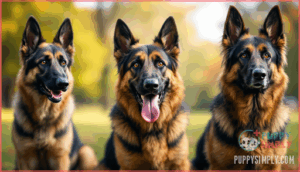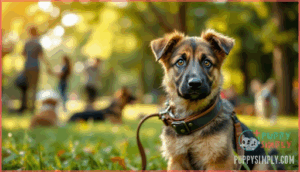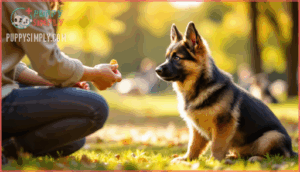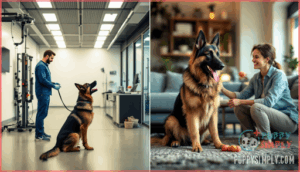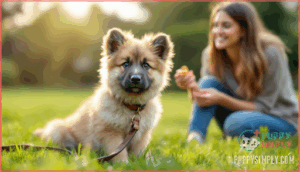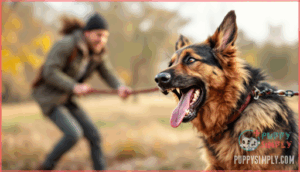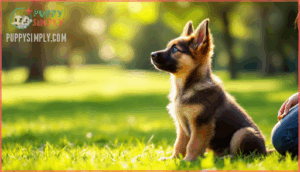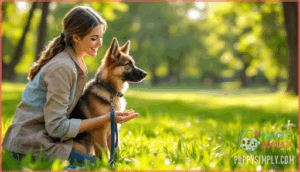This site is supported by our readers. We may earn a commission, at no cost to you, if you purchase through links.
 A German Shepherd sits perfectly during a training session, absorbing each command in under three repetitions—then bolts after a squirrel the moment you turn your back. This breed’s reputation for trainability isn’t hype; they genuinely rank among the smartest working dogs on the planet, mastering complex tasks that leave other breeds confused.
A German Shepherd sits perfectly during a training session, absorbing each command in under three repetitions—then bolts after a squirrel the moment you turn your back. This breed’s reputation for trainability isn’t hype; they genuinely rank among the smartest working dogs on the planet, mastering complex tasks that leave other breeds confused.
But intelligence doesn’t equal easy, and anyone who’s navigated the stubborn adolescent phase or managed leash reactivity knows this firsthand. The real question isn’t whether German Shepherds can learn—they absolutely can—it’s whether you’re ready to match their energy, consistency needs, and sensitivity with the right approach.
Understanding what makes these dogs tick, from their working heritage to their mental stamina, transforms training from a frustrating battle into a partnership that brings out their best.
Table Of Contents
- Key Takeaways
- Are German Shepherds Easy to Train?
- Key German Shepherd Personality Traits
- Why German Shepherds Respond Well to Training
- Common Training Methods for German Shepherds
- Training German Shepherd Puppies
- Differences in Training Males Vs. Females
- Addressing Behavioral Challenges
- Mental Stimulation and Exercise Needs
- How Long Does Training Take?
- Tips for Successful German Shepherd Training
- Frequently Asked Questions (FAQs)
- Conclusion
Key Takeaways
- German Shepherds rank third globally in intelligence and master new commands in fewer than five repetitions with 95% accuracy, but their smarts don’t make training effortless—adolescence brings stubborn phases (55% reduced responsiveness at 6–18 months) and reactivity challenges (25–35% show leash aggression) that demand consistent, patient handling.
- Daily exercise of 90+ minutes isn’t optional—it’s essential for focus and obedience, since 60% of German Shepherds without adequate physical and mental stimulation develop attention problems, destructive behaviors, and heightened reactivity that derail training progress.
- Positive reinforcement accelerates learning by roughly 30% and boosts recall accuracy by 28%, while harsh corrections backfire with this sensitive breed by increasing anxiety 70%—their emotional depth means they respond best to reward-based methods paired with clear, consistent commands across all household members.
- Early socialization between 3–14 weeks is critical, reducing adult aggression risks by 67% and improving obedience scores by 25%—starting training at 8 weeks rather than waiting until after 6 months makes puppies learn commands 75% faster and prevents behavioral problems from taking root.
Are German Shepherds Easy to Train?
Yes, German Shepherds are generally easy to train—but that doesn’t mean the process is without its bumps. Their sharp minds and eagerness to work make them quick learners, yet certain breed traits can throw a wrench in your training plans if you’re not prepared.
Let’s look at what makes them both a dream and a challenge to train.
Breed Intelligence and Obedience
Intelligence sets German Shepherds apart—they rank third globally in cognitive breed ranking, right behind Border Collies and Poodles. You’ll see impressive obedience scores when you start German Shepherd training: they master new commands in fewer than five repetitions and respond correctly about 95% of the time. As a breed, they’re considered highly trainable dogs, excelling in various roles.
Here’s what impacts their learning efficiency:
- Consistency matters more than anything—irregular training cuts obedience by 40%
- Early socialization boosts adult obedience scores by 25%
- Daily exercise of 90+ minutes keeps cognitive sharpness peaked
- Training in varied environments improves performance by 18%
These influencing factors make German Shepherd obedience training predictable when you understand breed comparison data.
Challenges in Training
While intelligence makes German Shepherds trainable dogs, you’ll face real behavioral problems. Reactivity tendencies surface during adolescence—25–35% of owners report leash aggression. Exercise needs aren’t negotiable; without 90+ minutes daily, 60% show poor focus and boredom behavior like household destruction. Stubborn phases hit between 6–18 months when 55% ignore commands. Their sensitivity response means harsh corrections backfire, increasing anxiety by 70%. Addressing German Shepherd reactivity and dog obedience training challenges requires understanding these patterns. German Shepherds aren’t inherently aggressive, but situational factors can contribute to aggression.
| Challenge | Impact | Solution |
|---|---|---|
| Reactivity tendencies | Leash aggression in 25–35% during adolescence | Early socialization (8–14 weeks) |
| Exercise needs | 60% show inattention without adequate activity | 90+ minutes daily structured exercise |
| Stubborn phases | 55% reduced responsiveness at 6–18 months | Consistent, short training sessions |
Key German Shepherd Personality Traits
Before you start training your German Shepherd, it helps to understand what makes them tick. Their personality shapes how they learn, what motivates them, and which challenges you’ll likely face.
Let’s look at three traits that define this breed and directly impact your training approach.
Loyalty and Protective Instincts
One bond defines the German shepherd above all else: their unwavering devotion to family. Rooted in their Historical Basis as 19th-century guard dogs, these breeds developed guarding instincts that make them naturally protective.
You’ll notice Behavioral Indicators like following you room-to-room and vigilant scanning when strangers approach—classic Bonding Patterns. Their protective instinct isn’t aggression; it’s calculated dog protection refined through Instinct Development.
Training Influence matters hugely here: early socialization before 12 weeks moderates over-guarding while strengthening healthy loyalty.
Energy Levels and Playfulness
That loyalty you’ve seen? It’s fueled by near-boundless energy. German Shepherds need 1.5–2 hours of physical exercise daily—runs, fetch, agility courses—to stay balanced.
But here’s the kicker: mental stimulation matters just as much. Puzzle toys and scent games tap into their problem-solving drive, reducing anxiety by half.
Puppies burst with play intensity until around age two, while working-line dogs demand even more activity than show-line counterparts. Without proper outlets, you’ll face destructive chewing and restlessness—classic signs of an under-stimulated shepherd.
Sensitivity and Reactivity
Beneath that confident exterior lies surprising emotional depth. German Shepherds carry genetic influences that shape their sensitivity—about 8% heritability for stranger-directed fear—making them prone to stress reactivity in certain environments.
Their German Shepherd temperament means they pick up on subtle cues others miss, which can trigger behavioral issues without proper management. Here’s what drives their reactivity:
- Environmental triggers like fireworks or urban chaos increase stress-induced behaviors by 40% compared to calmer settings
- Behavioral indicators such as body stiffness or panting signal overstimulation before full-blown dog reactivity emerges
- Early experiences matter enormously—puppies socialized before eight weeks show 30–40% lower stress responses later
Understanding these German Shepherd behavior problems helps you apply intervention strategies that work.
Why German Shepherds Respond Well to Training
German Shepherds aren’t just smart—they’re wired for work in a way that makes training feel almost natural. Their history, drive, and ability to pick up on what you’re asking all play into why they’re such quick learners.
Let’s break down what makes this breed so responsive when you put in the effort.
Working Dog Heritage
Your German shepherd’s drive to work isn’t just personality—it’s bred into their DNA. The breed was deliberately developed in 1899 from herding dogs in Thuringia and Württemberg, designed for versatility and task performance.
During WWI, they shifted from herding evolution to military service roles like communication and rescue. By WWII, over 15,000 worked in mine detection and guard duties.
Today, these working dogs serve in 90-plus nations’ police units, completing certification 25% faster than average breeds—a clear indication of breed development shaped by military influence in modern contexts.
Motivation and Drive
What fuels your shepherd’s eagerness to learn isn’t just intelligence—it’s the internal drives hardwired into the breed. Prey drive keeps them laser-focused during repetitive drills, while rank and pack drives make them naturally responsive to your leadership.
Positive reinforcement works best when timed within one second of the desired behavior, boosting learning speed up to 50%. This motivation translates into confidence that lasts throughout their working years.
Adaptability to Commands
Think of your shepherd’s brain like a smartphone that seamlessly switches between apps—that’s command generalization in action. They thrive with multimodal learning, absorbing cues through voice, gestures, and context simultaneously.
- Novel environments: Dogs trained across varied settings show 27% higher adaptability than those stuck in one location
- Cue alteration: German shepherd training excels when you change how commands are delivered—standing, sitting, or across distances
- Task switching: Your dog obedience work benefits from their ability to jump between different obedience commands without missing a beat
- Positive reinforcement: Reward-based methods boost recall reliability by roughly 25%, making command transfer smoother
This flexibility explains why German shepherd dog training translates so well from your backyard to busy streets.
Common Training Methods for German Shepherds
When training your German Shepherd, you’ve got a few solid approaches to choose from. The method you pick will shape how quickly your dog learns and how strong your bond becomes.
Let’s look at the main training strategies that work best for this intelligent breed.
Positive Reinforcement Techniques
Regarding German Shepherd training, positive reinforcement techniques work like rocket fuel for learning—studies show reward-based methods boost training speed by roughly 30%. High-value treats, like meat-based rewards, can increase recall accuracy by 28% in just four weeks.
Play reinforcement also sharpens focus by nearly 20%, making your training sessions more effective and enjoyable for your dog.
Consistency and Clarity in Commands
You can’t expect your German Shepherd to obey if your signals keep shifting—inconsistency in cues increases confusion by 40% in intelligent breeds. Training German Shepherds demands razor-sharp clarity and uniform household routines to realize their obedience potential.
- Command Repetition builds memory: Dogs trained four to five times weekly retain obedience commands three times longer than sporadic learners.
- Clear Delivery eliminates guesswork: Single-word dog commands yield 30% faster processing than multi-word phrases.
- Visual Cues heighten success: Pairing hand gestures with verbal cues boosts task completion by 45%, especially when Household Uniformity ensures everyone uses identical signals—Routine Impact strengthens reliability by 65%.
Professional Vs. Owner Training
Once you’ve established clarity and consistency, you’ll face a practical fork in the road: professional effectiveness versus owner engagement. Professional trainers push German Shepherds through obedience benchmarks 20–25% faster than owner-led methods, though training cost matters—group sessions run $250–$600 while board-and-train programs hit $2,500–$5,000.
Yet owners investing just ten daily minutes see 62% success rates in basic commands within twelve weeks, proving time investment and positive reinforcement beat expensive shortcuts when you’re consistent.
Training German Shepherd Puppies
Training a German Shepherd puppy sets the foundation for a well-behaved adult dog, but knowing where to start can feel overwhelming. Puppies are like sponges—they’re ready to learn, and getting the basics right early on makes everything easier down the road.
Let’s look at three essential areas every German Shepherd puppy owner should focus on from day one.
Socialization Best Practices
Since the critical period for puppy socialization runs from three to fourteen weeks, you’ll want to optimize controlled exposure during this window. Introduce your German Shepherd puppy to diverse people, animals, sounds, and environments using positive associations—treats and praise work wonders.
Early stimulation through varied textures and experiences builds confidence, while managing reactivity through gradual desensitization prevents fear-based behaviors. Proper German Shepherd puppy training and socialization during this phase deliver long-term benefits, reducing aggression risks by up to 67% in adulthood.
Housetraining and Crate Training
Housetraining your German Shepherd puppy works hand-in-hand with socialization. Start at eight weeks, and you’ll likely see reliable results between four to six months—89% of owners report significant progress within the first eight weeks. Crate training is your secret weapon here: 92% of experts recommend it, and puppies using properly sized crates have 70% fewer accidents.
Here’s what makes the difference:
- Establish a potty schedule — Take your puppy out first thing in the morning, after meals, post-naps, and before bed. Consistent timing cuts accidents by over 60% and speeds up German Shepherd puppy training by roughly two weeks.
- Make crate familiarization positive — Use treats, toys, and gradual time increases to ease anxiety. About 73% of puppies whine initially, but positive reinforcement reduces this by 80% within days.
- Implement accident solutions quickly — If mishaps happen, check crate size (too large creates bathroom zones) and increase bathroom breaks. Puppies need outings every one to two hours early on, with nighttime accidents most common under twelve weeks.
Routine benefits extend beyond housetraining—structured schedules reduce regression by 40% and help your shepherd adapt 30% faster to household rules.
Early Obedience Basics
Once your German Shepherd puppy masters housetraining, it’s time to start obedience training—ideally by seven to eight weeks old. Begin with the five essential commands: "sit," "down," "stay," "come," and "leave it."
Keep sessions to 5–10 minutes daily using positive reinforcement, and you’ll see your puppy learn new commands in just three to five repetitions.
This early training structure prevents behavioral issues and sets the foundation for later German Shepherd dog training.
Differences in Training Males Vs. Females
Regarding training, male and female German Shepherds can show some subtle differences in temperament and how they respond to your approach. These aren’t hard-and-fast rules, but many trainers notice patterns worth keeping in mind.
Here’s what you might expect when working with each.
Temperament Variations
Males and females exhibit distinct breed characteristics that significantly influence German shepherd training approaches. Males typically display stronger territorial instincts and dominance-related behaviors, whereas females score approximately 15% higher on attachment and agreeableness scales. These gender-based differences are rooted in both genetic heritability and bloodline variations within the German shepherd temperament.
| Trait | Males | Females |
|---|---|---|
| Territorial Behavior | Stronger guarding instincts; more marking and possessiveness | Moderate territoriality; less resource guarding |
| Emotional Maturity | Prolonged adolescence (6-8 months for obedience readiness) | Faster maturity (4-6 months for reliable responses) |
| Reactivity Thresholds | Higher dominance displays; benefits from neutering (25-30% reduction) | More cautious and affectionate; lower aggression rates |
| Socialization Impact | Requires extended consistency during training phases | Responds more quickly to early positive reinforcement |
Understanding these temperament and personality differences is crucial for tailoring effective training methods. Neutered males often exhibit reduced behavior problems, while females generally adapt more quickly to commands. Regardless of gender, both benefit equally from early socialization, which lowers reactivity thresholds by approximately 35%.
Response to Training Styles
While males and females share the same German shepherd training methods, their responses can differ dramatically. Males often require firmer boundaries when dominance methods surface, yet both genders excel with positive reinforcement—studies show 91% better retention. Handler experience matters more for territorial males, while females adjust faster across training contexts.
Both sexes thrive when you introduce environmental variation and avoid punishment-based German shepherd training approaches, which increase fear responses by 60%.
| Training Aspect | Males | Females |
|---|---|---|
| Positive Reinforcement Response | Strong motivation; may need higher-value rewards initially | Highly responsive; faster command acquisition (23% quicker) |
| Consistency Requirements | Benefits from structured routines; reduced confusion by 33% with clear cues | Naturally attuned to handler signals; adjusts to varied training techniques smoothly |
| Social Stimuli Sensitivity | Controlled exposure reduces reactivity by 38%; benefits from distraction training | Earlier socialization (before 16 weeks) yields 62% higher responsiveness to cues |
Addressing Behavioral Challenges
Even the smartest German Shepherds can develop habits that test your patience, from lunging at passing dogs to ignoring you when something interesting catches their eye. These behaviors aren’t signs of a bad dog—they’re often the result of their intense drive, high energy, and natural instincts kicking in without proper outlets.
Let’s look at three common challenges and how to work through them effectively.
Managing Leash Reactivity
Leash reactivity—barking, lunging, or growling on walks—affects roughly 13–18% of dogs and often stems from fear or frustration when movement is restricted. German shepherd training demands patience here, since their protective instincts can heighten dog reactivity without proper leash management and desensitization methods.
Here’s how to tackle it:
- Identify triggers early (other dogs, bikes, strangers) and keep your German Shepherd below threshold distance where they notice but don’t react, rewarding calm behavior consistently.
- Use training tools wisely—front-clip harnesses reduce pulling by 30%, while high-value treats accelerate counterconditioning during loose leash walking practice.
- Practice prevention strategies through gradual exposure over 8–12 weeks, maintaining slack leashes to lower anticipatory tension and building positive associations with formerly stressful stimuli.
If dog behavior doesn’t improve after consistent work, professional help can measurably reduce reactivity intensity and guide you through systematic desensitization suited to your shepherd’s needs.
Impulse Control and Focus
Teaching your German Shepherd self-control is like building a muscle—it strengthens with practice but takes time and patience. Inhibitory control ranks lower in shepherds compared to some herding breeds, meaning impulse control training demands structured repetition and developmental timeline awareness. Puppies start grasping basics around 12–16 weeks, but behavioral maturity arrives at 18–24 months.
Distraction-based training methods boost success rates by 65%, while commands like "leave it" and "wait" form the foundation of effective German Shepherd training. Breed considerations matter: your shepherd’s protective instincts can fuel impulsive reactivity, yet proper motivation through reward-based systems improves focus consistency within 4–6 weeks. Female dogs often demonstrate stronger self-control outcomes than males (mean scores 5.30 vs. 4.62), though individual variation exists. Training through adolescence enhances stability by 40%, turning scattered attention into reliable focus.
| Training Element | Impact on Self-Control |
|---|---|
| Distraction exposure | 65% improvement in impulse management |
| "Leave it" / "Wait" commands | Top 3 most effective exercises |
| Reward-based systems | Consistency gains in 4–6 weeks |
| Professional handling | 50% reduction in spontaneous reactions |
| Adolescent training consistency | 40% stability increase by age one |
Preventing Boredom and Destructive Behavior
A bored German Shepherd is like a ticking time bomb—without proper mental stimulation and physical exercise, destructive behaviors escalate fast. German Shepherd exercise needs hit 90–120 minutes daily, while enrichment variety through puzzle toys and scent games cuts destructive incidents by 50%.
Here’s your prevention toolkit:
- Rotate activities weekly: Snuffle mats, hide-and-seek, and trick training prevent habituation and reduce restlessness by 50%.
- Lock in routine consistency: Predictable schedules lower separation anxiety by 35% and minimize behavioral disorganization.
- Integrate training interventions: Problem-solving tasks during short sessions decrease boredom-driven misbehavior by 45%.
Environmental factors matter—vary your walking routes and incorporate outdoor exploration to satisfy their natural curiosity. Exercise importance can’t be overstated: dogs receiving balanced workouts show 65% fewer hyperactivity issues and threefold less destruction than under-stimulated counterparts.
Mental Stimulation and Exercise Needs
A well-trained German Shepherd isn’t just physically fit—they’re mentally sharp and engaged. These dogs need more than a quick walk around the block to stay balanced and well-behaved.
Let’s look at what it takes to keep your German Shepherd’s mind and body in top shape.
Daily Activity Requirements
Your German shepherd needs around 1.5 to 2 hours of physical exercise daily—think of it as non-negotiable fuel for both body and mind. Puppy exercise should start gently (5 minutes per month of age, twice daily), while senior activity drops to 30–60 minutes. Two to three sessions spread throughout the day work best, mixing walks, fetch, and obedience drills.
| Age Group | Daily Exercise Duration |
|---|---|
| Puppies (under 1 year) | 5 min per month of age, 2x daily |
| Adults (1–7 years) | 1.5–2 hours |
| Seniors (7+ years) | 30–60 minutes |
| All ages | 2–3 sessions recommended |
Exercise benefits go beyond burning energy—regular activity reduces anxiety, prevents obesity, and sharpens obedience responsiveness. Individual considerations like health status and temperament matter, so adjust activity frequency and intensity based on what you’re seeing in your dog.
Enrichment Activities for Training
Beyond burning off steam, enrichment activities like scent work tap into your German shepherd’s natural detection abilities—dogs can distinguish over 10,000 distinct scents, making nose games powerful mental workouts.
Puzzle toys, agility courses, and obedience drills woven into play sessions keep training German shepherds engaged while reinforcing positive reinforcement.
Interactive play like hide-and-seek or tug satisfies prey drive, strengthens your bond, and sharpens focus for German shepherd dog training.
How Long Does Training Take?
One of the first questions new German Shepherd owners ask is how quickly they’ll see results from training. The truth is, timelines can vary quite a bit depending on the dog and the owner’s approach.
Let’s break down what you can realistically expect and what factors speed up or slow down the process.
Typical Timelines for Basic Commands
Most German shepherds master basic commands in four to six weeks with consistent obedience training. Your training timeline depends on daily practice, keeping sessions brief and positive, and staying committed to the work even when adolescent setbacks test your patience.
- Sit, stay, and down: Most pups nail these fundamentals within the first month of focused German shepherd training
- Recall reliability: Expect longer work on "come" commands, as distractions challenge even smart dogs
- Housetraining duration: Full bladder control generally clicks between four and six months of age
- Command mastery progression: Basic obedience solidifies around six months, but off-leash trust takes additional time
- Long-term reinforcement needs: German shepherd dog training continues through age two or three to cement adult reliability
Factors Influencing Training Speed
Age shapes your progress more than you might expect—puppies under one year respond fastest but need shorter sessions, while seniors often slow down due to cognitive shifts. Genetics matter too; dogs from working lines excel 20-40% faster than pet-bred pups. Handler experience cuts learning time by up to 30%, and health directly impacts focus and physical participation.
Environment and German shepherd temperament also play roles—consistent routines and low-distraction spaces accelerate mastery of training methods specific to the German shepherd breed traits.
Tips for Successful German Shepherd Training
Training a German Shepherd takes skill, but it doesn’t have to be overwhelming if you follow a few key principles. Success comes down to understanding what works, staying committed to the process, and sidestepping the pitfalls that trip up many owners.
Here are three essential strategies that’ll set you and your dog up for long-term success.
Building a Strong Dog-Owner Bond
Training a German Shepherd isn’t just about commands—it’s about building a relationship. Shared activities like walks, play, and training sessions strengthen your bond considerably. Owners who train at least five times weekly report 62% stronger connections with their dogs.
Trust building through consistent routines and positive reinforcement creates emotional support that goes both ways, reducing anxiety and improving communication cues.
When you invest time in German Shepherd Dog Training, you’re not just teaching obedience—you’re creating a partnership built on mutual understanding and respect.
Maintaining Consistency and Patience
When you’re working on German Shepherd obedience training, command uniformity across everyone in your household can boost learning rates by 35%. Use identical words and gestures every time. Reinforcement timing matters too—reward within two seconds of the correct behavior to strengthen the association.
Embrace gradual progression rather than rushing; patience benefits include 40% better responsiveness and fewer behavioral relapses.
Routine schedules with short daily sessions keep your German Shepherd temperament balanced and focused, making positive reinforcement training far more effective long-term.
Avoiding Common Training Mistakes
If you start German shepherd training late—after six months—you’re facing a steep uphill climb, since puppies trained before sixteen weeks learn commands 75% faster.
Command inconsistency confuses your dog and drops success rates by 60%, so stick to identical cues. Overtraining risks burnout; sessions beyond thirty minutes tank attention by 55%.
Your emotions matter—frustration spikes cortisol and triggers shutdown. Finally, stop reinforcing negativity: giving attention during barking increases that behavior by 78%, undermining positive reinforcement training entirely.
Frequently Asked Questions (FAQs)
What age should German Shepherd training begin?
Your puppy’s future hinges on timing—start around 8 weeks when their brain is wired for learning. This critical socialization window between 3-12 weeks shapes whether your German Shepherd puppy develops into a confident companion or struggles with fear and reactivity.
Start German Shepherd training at 8 weeks—the critical 3-12 week socialization window determines whether your puppy becomes confident or reactive
Early training benefits include better impulse control and faster learning, while delayed training issues like aggression become harder to fix later.
Can German Shepherds be trained for protection?
Yes, German Shepherds excel at protection training due to their natural guarding instincts and high intelligence. Professional roles like police work show over 90% success rates.
Training costs range from $2,000 to $150,000 depending on intensity, making them top-tier guard dogs.
Do German Shepherds need specialized diet during training?
A German Shepherd diet during training doesn’t need to be dramatically different, but protein requirements and caloric intake do increase. Active dogs thrive on diets with around 22% protein and 1,800-2,500 calories daily—fuel for those sharp minds and tireless bodies.
Quality dog food, not supplements alone, builds the foundation for dog health and performance.
Are German Shepherds good for first-time owners?
They’re generally not ideal for first-time owners due to their high commitment level and complex training needs. Understanding dog behavior, German shepherd temperament, and breed characteristics is essential.
Without training experience, breed research, and realistic expectations about lifestyle fit, managing German shepherd behavior problems can overwhelm beginners.
How do rescue German Shepherds differ in training?
Rescue German Shepherds often carry trauma from past experiences, requiring extra patience and trust building during behavioral rehabilitation.
They may need longer to bond and overcome German Shepherd behavior problems before responding consistently to commands.
Conclusion
Training a German Shepherd isn’t about taking the path of leash resistance—it’s about channeling natural brilliance with consistent direction. Are German Shepherds easy to train? Absolutely, if you’re willing to match their drive, stay patient through adolescence, and provide the mental engagement they crave.
Their intelligence becomes your advantage when you establish clear boundaries, maintain routines, and treat mistakes as learning moments rather than setbacks. You’re not just teaching commands; you’re building a working partnership that rewards commitment with loyalty, focus, and a bond that outlasts every challenge.
- https://www.petlandnht.com/why-are-german-shepherds-so-smart/
- https://pmc.ncbi.nlm.nih.gov/articles/PMC9800387/
- https://cardioid-blenny-zz8k.squarespace.com/canine-obedience-training
- https://pdsapetstore.org.uk/collections/dog-grooming
- https://www.thekennelclub.org.uk/dog-breeding/the-kennel-club-assured-breeders/

